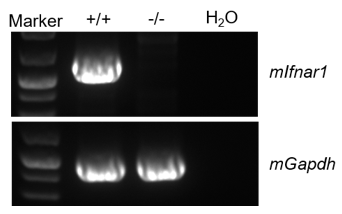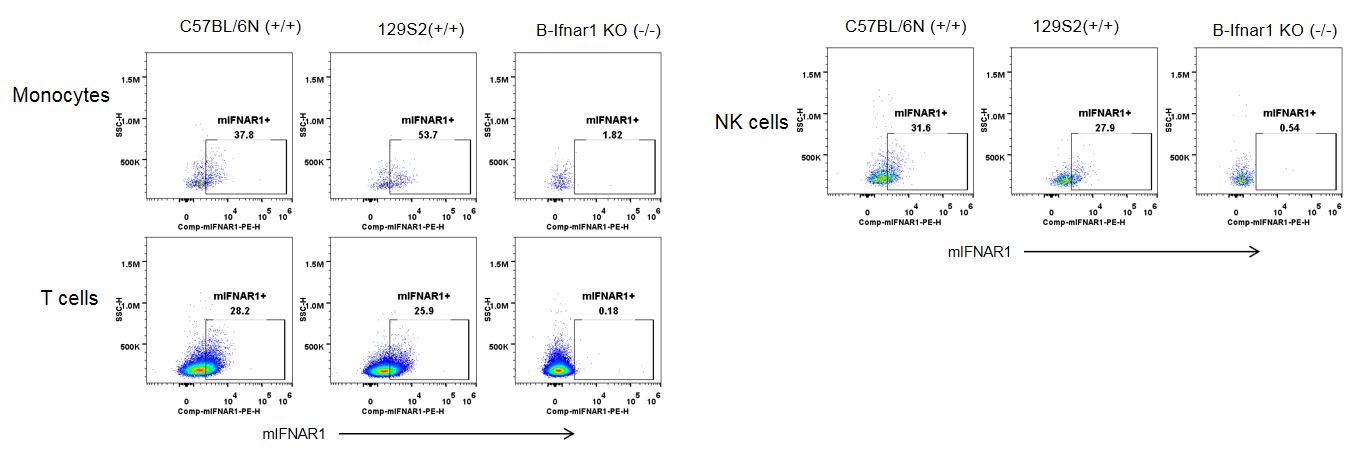B-Ifnar1 KO mice(129S2)
| Strain Name |
129S2/SvPasCrl-Ifnar1tm1Bcgen /Bcgen
|
Common Name | B-Ifnar1 KO mice(129S2) |
| Background | 129S2/SvPasCrl | Catalog number | 113249 |
|
Related Genes |
AVP, IFRC, IFNAR, IFNBR, IMD106, IFN-alpha-REC | ||
|
NCBI Gene ID |
3454 | ||
- IFNAR1, together with IFNAR2, forms the heterodimeric receptor for type I interferons. After binding with type I interferons, the IFNAR1/IFNAR2 receptor activates the JAK-STAT signaling cascade, which results in the transcriptional activation or repression of interferon-regulated genes.
- The knock-out mice developed normally.
- This model is useful in studying the role of IFN pathways in anti-viral and anti-microbial infections.
Gene targeting strategy for B-Ifnar1 KO mice(129S2). The genome sequences between exons 1-11 in mouse Ifnar1 gene were depleted in B-Ifnar1 KO mice(129S2). As a result, mouse IFNAR1 protein will not be expressed anymore.

Strain specific analysis of Ifnar1 mRNA expression in wild-type 129S2 mice and B-Ifnar1 KO mice(129S2) by RT-PCR. Spleen RNA were isolated from wild-type 129S2 mice (+/+) and homozygous B-Ifnar1 KO mice(129S2) (-/-), then cDNA libraries were synthesized by reverse transcription, followed by PCR with mouse Ifnar1 primers. Mouse Ifnar1 mRNA was only detectable in wild-type mice, but not in B-Ifnar1 KO mice(129S2).

IFNAR1 expression analysis in wild-type 129S2 mice and homozygous B-Ifnar1 KO mice(129S2) by flow cytometry. Spleen were collected from wild-type 129S2 mice (+/+) and homozygous B-Ifnar1 KO mice(129S2) (-/-). Protein expression was analyzed with anti-mouse IFNAR1 antibody (Biolegend, 127311) by flow cytometry. Wild-type C57BL/6N mice was used as a positive control for analysis. Mouse IFNAR1 was detectable in granulocytes, DC cells, B cells and macrophages from wild-type 129S2 mice, but not in those cell types from B-Ifnar1 KO mice(129S2).

Ifnar1 expression analysis in wild-type 129S2 mice and homozygous B-Ifnar1 KO mice(129S2) by flow cytometry. Spleen were collected from wild-type 129S2 mice (+/+) and homozygous B-Ifnar1 KO mice(129S2) (-/-). Protein expression was analyzed with anti-mouse Ifnar1 antibody (Biolegend, 127311) by flow cytometry. Wild-type C57BL/6N mice was used as a positive control for analysis. Mouse IFNAR1 was detectable monocytes, T cells and NK cells from wild-type 129S2 mice, but not in those cell types from B-Ifnar1 KO mice(129S2).









